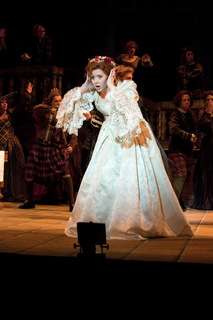|
Back
Donizetti Slashed in Princeton Philadelphia
McCarter’s Matthews Theatre
07/10/2009 - & July 18, 26
Gaetano Donizetti: Lucia di Lammermoor
Lisette Oropesa (Lucia), Jonathan Boyd (Edgardo), Eric Dubin (Enrico), Taylor Stayton (Arturo), Rubin Casas (Raimondo), Cathleen Candia (Alisa), Paul Nicosia (Normanno)
New Jersey Symphony Chamber Orchestra, Michael Ching (conductor)
Carey Wong (set designer), Patricia A. Hibbert (costume), Barry Steele (lighting designer), John Hoomes (stage director)

L. Oropesa (© Bruce Fuller)
Opera New Jersey has expanded ambitiously but carefully since 2004 when the company opened its first season in a small performing space at Princeton University. Now in its sixth season, Opera New Jersey is putting the New Jersey Symphony Chamber Orchestra into the pit as it moves two of its three productions into Matthews Theatre, the 1,100-seat auditorium in the McCarter Theatre Center for the Performing Arts. Lucia di Lammermoor, the opera that’s opening ONJ’s summer festival season, shows the company needs to make some further improvements to reach its goals. This Lucia needs stronger casting and a more consistent staging. Lisette Oropesa, a soprano leggiero with Metropolitan Opera credits, performs the title role capably, but she is surrounded by light-weight voices lacking the vocal heft and intensity to realize the drama in Donizetti’s demanding music.
Stage director John Hoomes creates some energy and intensity on the stage until the blood starts to flow after Lucia murders the man she is forced to marry. The blood-drenched corpse of Arturo is carried across the stage. Then Lucia appears, her bloody arm holding aloft a dripping dagger. During the Mad Scene, this Lucia slashes her brother’s face – more blood – before she stabs herself. Is the gore overdone? Yes. So are some of the extraneous touches Hoomes adds, touches like the murder pantomime that disfigures the prelude to the opening act. Michael Ching, a familiar face in the orchestra pit, does some slashing of his own. Ching leads a musical performance notable for its rhythmic propulsion and clear textures. Alas, he mutilates Donizetti’s music with major cuts. This Lucia di Lammermoor is shorn of the second–act duet for Lucia and Raimondo and the thrilling duet for Edgardo and Enrico that opens the last act. Many other scenes are trimmed.
Carey Wong’s sets and Patricia A. Hibbert’s costumes make a mixed impression. Wong’s Gothic castle features ivy-colored stone colonnades and balustrades. The budget must have run out before the colorless costumes were stitched together. Hibbert’s drab designs do not flatter the singers. Neither does Barry Steele’s lighting. Steele overlays the final scene with a confusing tangle of projected images.
Oropesa provides the shining voice that holds together this undersung and overstaged Lucia. A slight woman with a slender voice, she moves well and often sings exquisitely. Her radiant voice soars through “Regnava nel silenzio” and then sparkles in the rapid figurations of “Quando rapito in estasi.” Oropesa spins out the long lines of “Verrano a te” in a stream of limpid, pure sound. Despite the overdrawn theatrics in Hoomes’ staging, Oropesa gives an assured account of the Mad Scene. Looking girlish and dazed, the auburn-haired soprano sings exquisitely. She caps the scene with an interpolated high E flat, although – to her credit – she ducks the first E flat shrieked out by most sopranos after the long flute cadenza.
Oropesa is not the only singer who soars into the vocal stratosphere. Tenor Jonathan Boyd screams out the E flat that caps the first-act duet for Lucia and Edgardo – the soprano sings only a high C there. Boyd battles an ugly costume as well as the music that demands a tenor with more vocal heft than he can supply. In the more lyrical portions of Edgardo’s music, he sings sweetly and attractively. The dramatic outbursts, however, test his stamina. On opening night, the tenor choked disastrously in the curse that caps the Wedding Scene.
Eric Dubin sings ably as Lucia’s oppressive brother, Enrico. His compact baritone has a dark color and a firm tone but is several sizes too small for this demanding part. In spite of his limitations, Dubin makes a positive impression and wins applause from the audience. Rubin Casas stepped into Raimondo Bidebent’s shoes to replace Matthew Burns whose name appears in the program. Like the tenor and baritone, Casas forces his voice to produce the sonorous sound required for Raimondo’s “Dalle stanze” before Lucia’s Mad Scene. As Arturo, tenor Taylor Stayton sings securely but is forced to wear an unsightly wig. Rounding out the cast are Paul Nicosia (Normanno) and Cathleen Candia (Alisa).
Robert Baxter
|